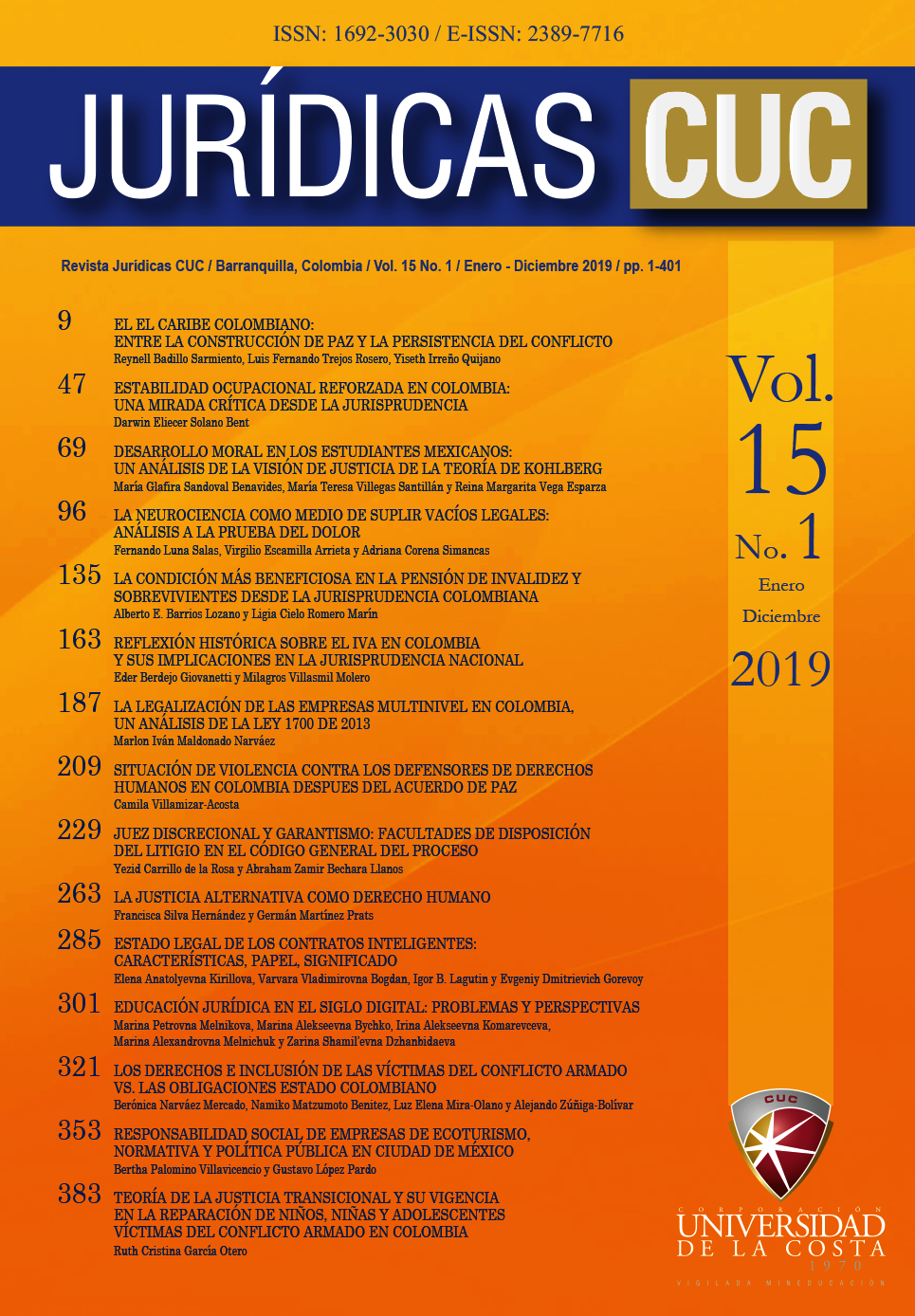Estado legal de los contratos inteligentes: características, papel, significado
DOI:
https://doi.org/10.17981/juridcuc.15.1.2019.11Palabras clave:
entorno digital, tecnología blockchain, intermediarios, mensajes legalmente significativos, relaciones legales, contrato inteligenteResumen
Este artículo mediante el criterio metodológico del análisis crítico examina el estado legal de los contratos inteligentes, sus particularidades, características y la posibilidad de introducir esta categoría en el campo legal. El objetivo principal del estudio es determinar el estado legal de los contratos inteligentes, y la posibilidad de aplicación en el derecho civil. Durante el estudio se llegó a la conclusión de que el contrato inteligente es un código de programa, basado en la tecnología blockchain, la cual por sus características legales es un mensaje legalmente significativo escrito en un idioma (lenguaje artificial) y respaldado por la firma digital electrónica de cada una de las partes. Se ha demostrado como las interacciones multilaterales realizadas a través de contratos inteligentes permiten reducir los costos de la realización y control de las operaciones, aumentar la velocidad de las operaciones y reducir los riesgos asociados con las acciones desleales de las partes.
Descargas
Citas
Allam, Z. and Dhunny, Z. A. (2019). On big data, artificial intelligence and smart cities. Cities, 89(1), 80–91. https://doi.org/10.1016/j.cities.2019.01.032
Annalect. (October 12, 2017). Blockchain pulls marketing into uncharted territory. [Online]. Retrieved from: https://www.annalect.com/blockchain-pulls-marketing-into-uncharted-territory/
Ashraf, A. R., Thongpapanl, N. and Auh, S. (2014). The application of the technology acceptance model under different cultural contexts: The case of online shopping adoption. Journal of International Marketing, 22(3), 68–93. https://doi.org/10.1509/jim.14.0065
Barinova, A. and Zapechnikov, S. (2017). On the techniques and tools for privacy-preserving smart contracts. Bezopasnost informacionnyh tehnology, 24(2). 16–23 https://doi.org/10.26583/bit.2017.2.02
Bradbury, D. (2013). The problem with bitcoin. Computer Fraud & Security, (11), 5–8. https://doi.org/10.1016/S1361-3723(13)70101-5
Clack, C. D., Bakshi, V. A. and Braine, L. (2016). Smart Contract Templates: foundations, design landscape and research directions. Barclays Bank PLC. 1–15. Retrieved from: https://arxiv.org/pdf/1608.00771.pdf
Giancaspro, M. (2017). Is a ‘smart contract’ really a smart idea? Insights from a legal perspective. Computer Law & Security Review, 33(6), 825–835. https://arxiv.org10.1016/j.clsr.2017.05.007
Habibzadeh, H., Nussbaum, B. H., Anjomshoa, F., Kantarci, B. and Soyata, T. (2019). A survey on cybersecurity, data privacy, and policy issues in cyber-physical system deployments in smart cities. Sustainable Cities and Society, 50(1), 101660. https://doi.org/10.1016/j.scs.2019.101660
Hackett, R. (2017). Blockchain mania. Fortune, 178(3), 44–59.
Hazard J. and Hardjono, T. (2016). CommonAccord: Towards a Foundation for Smart Contracts in Future Blockchains. [W3C Position Paper]. Cambridge: MIT Media Lab. Retrieved from: https://www.w3.org/2016/04/blockchain-workshop/interest/hazard-hardjono.html
Hou, J. (2018). Destructive sharing economy: A passage from status to contract. Computer Law & Security Review (Forthcoming), 34(4), 965–976. Retrieved from: https://ssrn.com/abstract=3173588
Icertis. (2017). Smart contracts are transforming the way we do business – a Newsletter Featuring Gartner Research. [Online]. Retrieved from: https://www.icertis.com/resource/smart-contracts-are-transforming-the-way-we-do-business-featuring-gartner-research/
Kirillova, E. A., Bogdan V. V., Golovatskaya, M. V., Melnichenko, T. A. and Ognev, V. N. (2018). Legal Significance of Electronic Messages and Documents. Journal of Advanced Research in Law and Economics (JARLE), 9(3(33)), 997–1100. https://doi.org/10.14505//jarle.v9%203(33).25
Lauslahti, K., Mattila, J. and Seppälä, T. (2017). Smart Contracts – How will Blockchain Technology Affect Contractual Practices? [ETLA Reports, 68]. Helsinki: ETLA. Retrieved from: https://www.etla.fi/wp-content/uploads/ETLA-Raportit-Reports-68.pdf
Low, K. F. K. and Teo, E. (2018). Chapter 10: Legal Risks of Owning Cryptocurrencies. In D. L. K. Chuen and R. Deng, Handbook of Blockchain. Digital Finance, and Inclusion, Volume 1. Cryptocurrency, FinTech, InsurTech, and Regulation. (pp. 225–247). Singapore: Elsevier. https://doi.org/10.1016/B978-0-12-810441-5.00010-5
Luu, L., Chu, D-H., Olickel, H., Saxena, P. and Hobor, A. (2016). Making Smart Contracts Smarter. In ACM SIGSAC, Conference on Computer and Communications Security, CCS ‘16 (pp. 254–269). Vienna, Austria. http://dx.doi.org/10.1145/2976749.2978309
Pacini, C., Andrews, C. and Hillison, W. (2002). To agree or not to agree: Legal issues in online contracting. Business Horizons, 45(1), 43–52. http://dx.doi.org/10.1016/S0007-6813(02)80009-X
Rosic, A. (octubre 28, 2016). Smart contracts: The blockchain technology that will replace lawyers. [Blog]. Retrieved from: https://blockgeeks.com/guides/smart-contracts/
Sullivan, C. (2018). Digital identity – From emergent legal concept to new reality. Computer Law & Security Review, 34(4), 723–731.
Szabo, N. (1994). Smart Contracts. [Online]. Retrieved from: http://www.fon.hum.uva.nl/rob/Courses/InformationInSpeech/CDROM/Literature/LOTwinterschool2006/szabo.best.vwh.net/smart.contracts.html
Underwood, S. (2016). Blockchain beyond bitcoin. Communications of the ACM, 59(11), 15–17. http://dx.doi.org/10.1145/2994581
Ye, G. and Liang, C. (2016). Blockchain application and outlook in the banking industry. Financial Innovation, 2(1), 1–12. http://dx.doi.org/10.1186/s40854-016-0034-9
Yuanfeng, C. and Dan, Z. (2016). Fraud detections for online businesses: a perspective from blockchain technology. Financial Innovation, 2(1), 1–10. http://dx.doi.org/10.1186/s40854-016-0039-4
Descargas
Publicado
Cómo citar
Número
Sección
Licencia
Derechos de autor 2019 JURÍDICAS CUC

Esta obra está bajo una licencia internacional Creative Commons Atribución-NoComercial-SinDerivadas 4.0.
Los artículos publicados son de exclusiva responsabilidad de sus autores y no reflejan necesariamente las opiniones del comité editorial.
La Revista JURIDICAS CUC respeta los derechos morales de sus autores, los cuales ceden al comité editorial los derechos patrimoniales del material publicado. A su vez, los autores informan que el presente trabajo es inédito (original) y no ha sido publicado anteriormente.
Contrato de cesión de derechos patrimoniales de autor
Formato de certificación de originalidad del artículo por parte del autor
La revista JURÍDICAS CUC se guía por las normas internacionales sobre propiedad intelectual y derechos de autor, y de manera particular por el artículo 58 de la Constitución Política de Colombia, la Ley 23 de 1982 y la ley 1915 de 2018.


 English
English
 Español (España)
Español (España)



